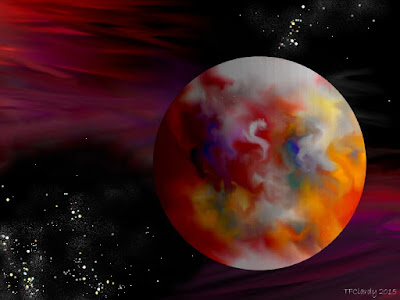Life of other worlds: drawings and sketches from one space explorer's travel journal is a series focusing on various other star systems in the Milky Way Galaxy.
 |
| The Odin Star System (NOTE: Planet and orbits not to scale) |
The
Odin System is a yellow star system consisting of six planets. Balder and Njord
are the only planets with life forms.
Dr. Dag Stassen discovered the system during the exploration mission of the
European Space Agency Interplanetary Space Probe in the early 21st
century. The ESA gave it names
according to mythological Norse gods and goddesses.
 |
Frigg
|
The first four planets are rocky. The last two planets are gas giants; Thor
being a super gas giant. Between the
two gas giants there is a large asteroid field called The Valkyries, which
contains some of the largest asteroids ever recorded. The gas giants, Thor and Loki, seem to keep the asteroids in
check and corralled into their orbit around the star Odin. Without Thor and Loki, the asteroids would
cause havoc within the system. However,
it is believed that the gravitational pull of the collective asteroid belt and
Loki prevented Thor from being pulled further into the system, thus keeping the
inner planets safe. (Note: Planets and their orbits are not to scale.)
Frigg
The first planet is Frigg, named after the wife of Odin and goddess of married love. It is geologically inactive with a high surface temperature.
 |
Hel
|
Hel
The second planet in the Odin System is called Hel, named after the Norse goddess of death. Hel is a turbulent geologically active planet which lives up to its name.
Balder
 |
| Balder |
The third planet Balder is an Earth-sized world with a
similar gravity and atmosphere. It is named after the Norse god who was the son of Odin and the favourite of the gods. It has
one moon named Hoder. Balder is a geologically active planet with a continuous
rocky, mountainous terrain. Unlike
Earth, Balder contains most of its water underground. Caves are a common geological form. Water on Balder has a very
high mineral content and is very saline.
Most of the large creatures on Balder exhibit qualities of both reptiles
and mammals on Earth. Plant life
consists mostly of lichen-like and moss-like plants. Vines are the dominant plant, covering rock spires and mountain
ranges, sometimes reaching several meters in diameter.
 |
| A repto-mammal that hangs from cliffs and lures in small flying nectar-sucking creatures - its mouth resembles a certain flower and oozes oil that smells like the nectar. |
 |
One of the exobiologists on the team stated that this was not a dinosaur. I beg to differ. |
.
 |
An actual flying snake, well it was really more of a clumsy glider, flapping and gliding from one cliff to the other. The landscape was littered with high jutting cliffs, making this creature quite at home
|
Njord
 |
| The chilly water world of Njord |
The fourth planet Njord is a
chilled water world. It is named after the Norse god of ships and the sea. It has one moon,
Aegir.
Njord is 82% water. Its planetary climate resembles that of the
Northern Pacific and Atlantic Oceans on Earth.
Most of the dry land consists of large mountainous archipelagos near its
equator. The equatorial ocean is more
shallow and warmer than the deep, usually frozen, polar ocean.
Aquatic life on Njord is
extremely diverse. The largest numbers
of species resemble the fish of Earth. There are no mammal-like creatures anywhere
on the planet. Most of the scientists
that have explored Njord say that it resembles Earth during its Devonian Era,
though much colder.
One of the surprises of Njord
is the existence of several large shark-like creatures. The largest carnivore creature on the
planet, the Fury Fish (Pistrix furiosus) make the
Earth's sharks seem tame in comparison. After the
death of several explorers, a planet-wide caution is in place to anyone near a
body of water that is connected to the open ocean.
 |
| the Fury Fish (Pistrix furiosus |
 |
| Pistris piscatus - Distant cousin to the Fury Fish, this creature takes a gulp of water into its "blowhole", and then pulls itself through shallows (and sometimes on to shore) using its arm-like fins in order to capture trapped prey. |
 |
Pistrix tenoris -- Related to the Fury Fish, this slow relation uses baleen to sieve the waters of the ocean world of Njord. |
Thor
 |
| Thor |
Thor, named after the Norse god of thunder and the sky, is a gas super
giant. It has two rocky moons, Fjorgynn
and Sif. The moons are warm desert
worlds even though they are in the planetary cold zone. As a gas supergiant, Thor radiates heat,
passing it along to its moons. Due to
the distance from the inner planets and solar winds, Thor’s heat has little
effect upon the smaller planets of the system.
Loki
Loki is the last planet of the system. It is named after the Norse god of mischief.
It is a gas giant, with one moon named Sigyn.
 |
Loki
Next in the series : The Aten-Ra Star System
|























































